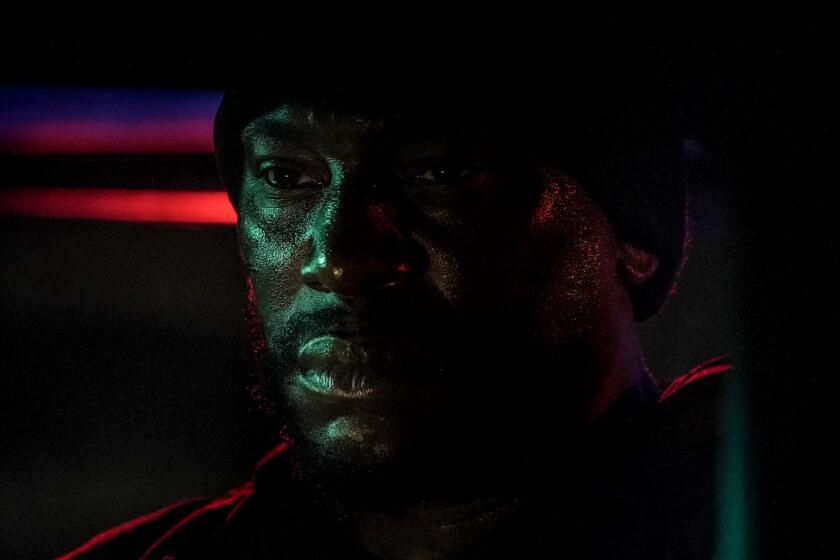The writer, the artist and an enduring love
Esteemed British writer Christopher Isherwood met 18-year-old Don Bachardy at Will Rogers State Beach in October 1952 and by early the next year, the two had begun an intimate relationship that lasted until Isherwood’s death in 1986. They were a high-profile, openly gay couple whose meeting coincided with one of the most homophobic decades in American history, the era of McCarthyism, when homosexuals were being driven out of the State Department.
Yet to the gay community at large, as well as those who were casually acquainted with the couple, Isherwood and Bachardy seemed to live an enviably idyllic existence in their hillside Santa Monica home, where they entertained the leading figures of the world of arts and letters, and the movie stars that Bachardy once sought out for autographs. For all that seeming perfection, Guido Santi and Tina Mascara’s loving yet clear-eyed documentary, “Chris & Don: A Love Story,” reveals that the couple worked hard and long to achieve their bliss.
In it, Bachardy, who was interviewed by the filmmakers nine times over several years, talks about some of those challenges. He was subjected to considerable homophobia in Hollywood, he says, directed pointedly at him rather than Isherwood, who was protected by his celebrity status. And Evelyn Hooker, the psychologist whose 1950s research showing that homosexuality is not a mental illness helped launch gay liberation, asked Isherwood to leave the guest cottage he rented from her when Bachardy moved in with him.
What intrigued Santi as a filmmaker was the pair’s love story and, beyond that, the young Bachardy’s growth as an important portrait artist, emerging from the sometimes overpowering shadow of Isherwood’s literary renown. From the start, the men’s relationship was challenging: Bachardy was 30 years Isherwood’s junior and was so boyishly handsome as to look underage. A UCLA student in languages and theater arts when they met, he soon felt overwhelmed by Isherwood’s vast array of famous friends. But Isherwood encouraged Bachardy’s talent for drawing and, in a relatively short time, Bachardy became an internationally acclaimed artist in his own right.
Still strikingly handsome and a fitness buff at 74, Bachardy remains prolific. He is fond of saying that he is completely Isherwood’s creation, but the film suggests that Isherwood’s writing also was shaped through the openness of their relationship.
“It was so extraordinary,” says Santi at a mid-city restaurant recently with Mascara. “Think of the age difference, that they were both artists, that they lived so openly and were so in love. For the 1950s, this was certainly unusual and unacceptable to most people.”
About a decade ago, Santi’s friend Julia Scott, a producer whose family knew the couple, introduced Santi to Bachardy. When Bachardy showed Santi, a producer-director of TV specials and documentaries, some 16-millimeter footage he had shot on a 1956 European vacation with Isherwood, the inspiration for “Chris & Don” was born. Santi was unable to launch the project on his own, but soon after he and independent filmmaker Mascara became a couple, they embarked on what became a 4 1/2 -year project to make the film, which opens Friday at the Nuart in West Los Angeles.
The two still had no funding but managed to charge the costs of a camera and editing system to their credit card. “What kept the project alive for such a long time was how we felt about Don and his relationship with Isherwood,” Santi says. To enhance the Bachardy interviews, the filmmakers drew from both his and Isherwood’s diaries, interviewed such friends of the couple as director John Boorman and actress Leslie Caron, and culled through a treasure trove of photo stills, home movies and archival interviews with Isherwood.
Helping maintain the film’s easy narrative flow are several subtly glimpsed re-created moments punctuated by some amusing and tender animated sequences expressing the men’s enduring love.
Friend Michael York provides the voice for Isherwood’s remarks in the film, and Bachardy mischievously reveals that Isherwood liked York in the film version of “Cabaret,” the musical derived from the writer’s Berlin stories, as much as he disliked Liza Minnelli, believing her to be “too professional” an entertainer to play an amateur like his heroine Sally Bowles.
“That we didn’t succeed in getting grants to make our film, I have to say, was a blessing,” Mascara says. “We had to be more creative and made a better film as a result.”
More to Read
Only good movies
Get the Indie Focus newsletter, Mark Olsen's weekly guide to the world of cinema.
You may occasionally receive promotional content from the Los Angeles Times.










